What is the current focus of your research? My colleagues and I are presently addressing quality of vision following refractive and cataract surgery. One of our recently published articles illustrates how the optical zone shrinks with increasing amounts of excimer laser treatment. At this time, I am refining our ASTRA_PRO software, from LaserSight, Inc., for customized prolate corneal ablations. I am also very excited about my work with Pharmacia and their Tecnis lens. The improvement in patients' quality of vision with this lens is remarkable.
Tell us about your background in engineering. I finished my master's of electrical engineering degree in 1971 at Southern Methodist University in Dallas and began work on my PhD with a subspecialization in biomedical engineering. I found the medical applications of engineering very exciting. During medical school, I kept my engineering skills sharp by working part-time as a computer programmer for the medicine department, and then with research projects in ophthalmology. It was during this time that I developed my first ophthalmic device, the Brightness Acuity Tester from Marco, used for glare testing in cataract patients.
How has this background impacted your career? During my undergraduate and graduate training in engineering, I was fortunate to work part-time at a company that created many night-vision devices for the military. Devices such as infrared viewers and image intensifiers had just been developed, and environmental testing and refinements were in progress. This work gave me a great deal of exposure to design optics and applications to vision. This optical background is critical for my current work in refractive and cataract surgery. Wavefront technology, contrast sensitivity, and topography are all tools that we have developed and refined based on the principles of electrical engineering. Today, it is even more important with our lasers and the improved optical design of IOLs. My optical background is what made IOL calculations so interesting.
What prompted you to create the Holladay IOL Consultant and the Refractive Surgery Consultant software programs? I received daily requests for help with IOL calculations and refractive surgery nomograms. It became impossible for me to answer all of the requests, and I developed these programs so that doctors could perform their own calculations. The feedback that I have received from the hundreds of doctors and technicians using the programs has been very rewarding. We are continually refining and updating these programs, and I will always be working on new software packages.
What do you predict to be the next breakthrough innovation in ophthalmology? I believe there will be two giant steps in the next few years. The first is with the optical design of IOLs. The Tecnis lens has a modified prolate optic and significantly improves contrast sensitivity by approximately 40%, as well as quality of vision. I believe this is the biggest improvement in IOL optics since ultraviolet inhibitors were included in IOLs. The second major step will be in excimer lasers. They will no longer make the cornea oblate and will instead make it prolate, as it should be. I have performed approximately 40 prolate ablations, and the quality of vision is much better than with our current oblate treatments.


